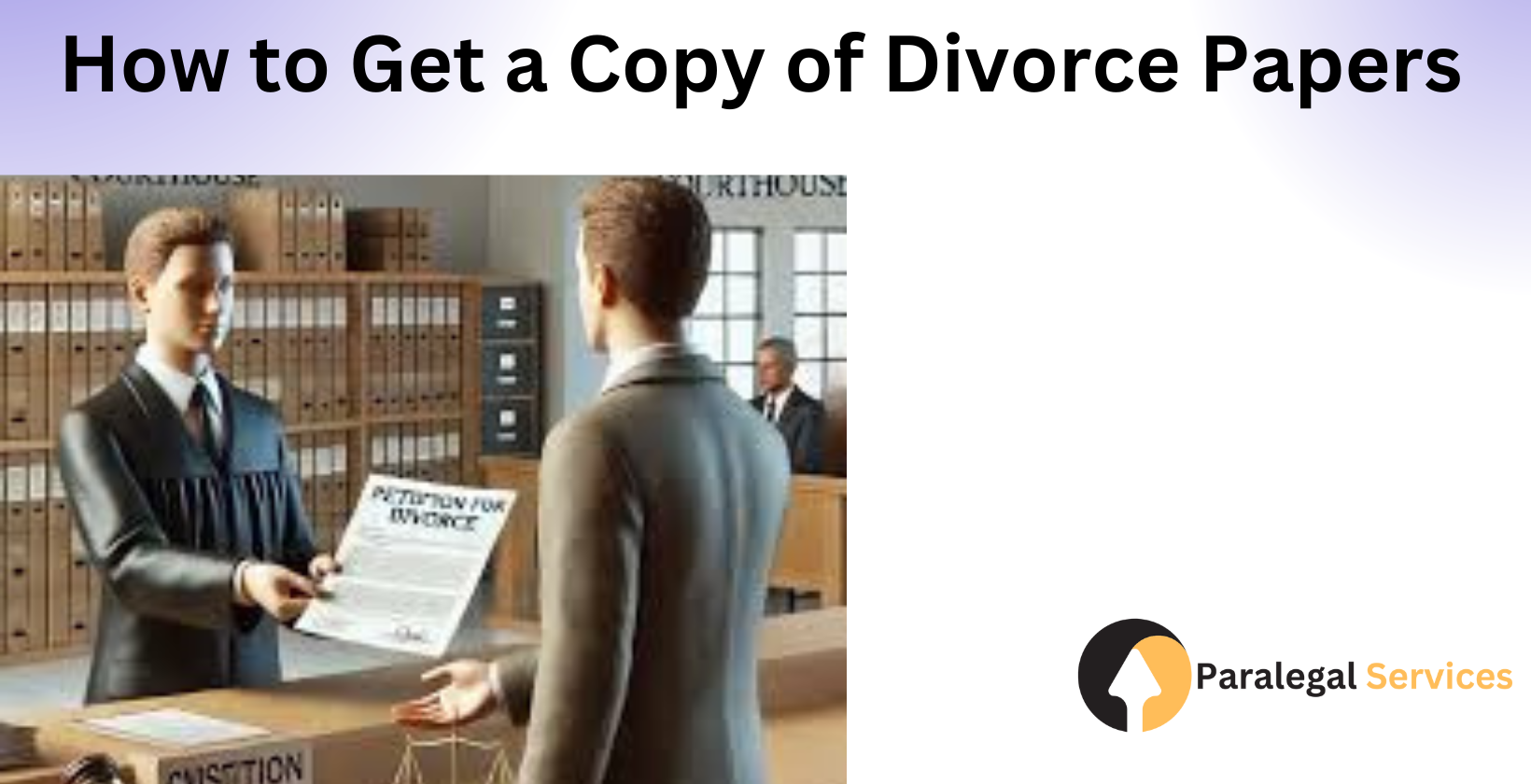Divorce papers are legal documents that officially end a marriage. They include the divorce decree, which is the court’s final ruling, and may contain settlement agreements, custody orders, or property division details. These documents prove critical for legal, personal, and administrative tasks. Obtaining them ensures compliance with requirements for remarriage, tax adjustments, name changes, or custody updates. The process to secure these papers depends on the jurisdiction where the divorce occurred, such as the specific country, state, or county. Typically, individuals must contact the court or a designated government office that processed the divorce.
People need divorce papers for various reasons. Remarriage often requires proof of prior divorce to confirm eligibility. Tax filing may demand these documents to verify changes in status or dependents, especially when claiming deductions. Name changes, like reverting to a maiden name, rely on divorce papers for legal validation. Custody arrangements or modifications frequently reference these records to enforce or alter terms. Procedures vary widely, so understanding local rules is essential.
Where Can I Get Original Divorce Papers?
Official sources for original divorce papers differ by jurisdiction. The family court that finalized the divorce usually holds these records. In many areas, the county clerk’s office or state vital records office serves as an alternative, based on local regulations. In the United States, divorce records are commonly stored at the county level—contacting the county clerk where the divorce was granted is standard. Some states, like California, centralize records through the California Department of Public Health’s Vital Records office. In the UK, the court that issued the divorce decree provides access, such as through HM Courts & Tribunals Service.
Parties to the divorce, meaning the ex-spouses, can request copies with proper identification, such as a driver’s license or case number. Third parties, including lawyers or researchers, face stricter rules. They must justify their request and may need court approval, particularly when privacy laws apply, like under the U.S. Family Educational Rights and Privacy Act principles for sensitive records. Identity verification prevents unauthorized access—forms or fees might be required. Regional differences matter: New York restricts third-party access more than Texas, while UK courts demand precise case details.
How Can I Get Divorce Papers Online?
Digital access to divorce papers exists through various platforms. Court websites in many jurisdictions, such as Florida’s e-courts system, allow users to search and download records directly. Government portals, like VitalChek in the U.S., offer request services for digital or mailed copies. Third-party legal services, such as LegalZoom, provide convenience but charge fees. Limitations persist: older records, predating digitization efforts in the 1990s, often remain offline. Authentication—via account creation or ID submission—is standard, and certified copies typically cost $10-$20, per a 2021 National Center for State Courts survey.
Not every jurisdiction supports online access fully. Time restrictions apply; some courts delay digital availability for 30-60 days post-divorce. Users search with phrases like “download divorce papers online free” or “access divorce decree digitally.” Free previews might exist, but official documents require payment. Reliability varies—official sites outrank third-party options in accuracy, as noted in a 2022 University of Maryland study on public record access. Stick to government or court portals to avoid outdated data.
What Information Is Included in Divorce Papers?
Divorce papers are a collection of legal documents that outline the terms and conditions of a divorce. They typically include several key components. The petition for dissolution is the initial request to end the marriage, filed by one spouse, known as the petitioner. The summons is a document that notifies the other spouse, called the respondent, about the divorce proceedings and requires a response. Property division details how assets and debts are split between the parties, while custody agreements cover arrangements for any children, including living situations and support payments. The final judgment or decree is the court’s official ruling that legally ends the marriage. These papers often contain both legal declarations, like the court’s decisions, and agreements negotiated between the spouses, such as who keeps the house or how visitation works.
The specific contents of divorce papers can differ depending on where the divorce happens because each jurisdiction has its own rules. For example, some places might require extra forms about income or parenting plans. Users might see legal terms like “dissolution,” which just means ending the marriage, or “jurisdiction,” which refers to the court’s authority over the case. These terms help make the process official, but they’re straightforward once explained—divorce papers are essentially the roadmap for legally unwinding a marriage, tailored to the local system and the couple’s situation.
How Can I Obtain a Divorce Decree?
A divorce decree is the final, court-approved document that legally ends a marriage. It’s different from general divorce papers, which include all the forms and filings used during the process, and a divorce certificate, which is a basic record proving the divorce happened. To get a divorce decree, you need to request it from the court or county clerk where the divorce was filed. You’ll usually have to provide specific details, like the case number, the date of the divorce, and some form of identification, such as a driver’s license or passport. The process might involve filling out a request form, paying a small fee, and choosing whether to pick it up in person, get it mailed, or download it if the court offers online access.
If someone else, like a lawyer or an insurance company, needs the decree, they can request it too, but they’ll need proper authorization—think a signed permission slip from you or a court order. Courts set these rules to protect privacy while still allowing access when there’s a legitimate reason. It’s a pretty simple process once you know where to go and what to bring, though it can vary a bit depending on the local court’s setup.
Where Can I Access My Original Divorce Decree?
You can access an original divorce decree from official sources like the county clerk’s office, the family court records department, or the state vital records office where the divorce was finalized. How you get it depends on the place—some offer in-person pickup, others let you order by mail, and a few have online systems. An “original” decree usually means a certified copy, which is an official version stamped and verified by the issuing authority, not just a photocopy you might have at home. If you were part of the divorce, you’ve got the right to grab a copy anytime, but public access is trickier—outsiders might need a good reason or special permission because these records aren’t always open to everyone.
There can be hiccups, though. Sealed records, often for sensitive cases, might need a court order to open. Older divorces could be archived off-site, meaning it takes longer to dig them up—like weeks instead of days. For instance, in some states, decades-old records get shipped to a central archive rather than staying at the local courthouse. Knowing the right office and their rules makes all the difference in tracking down that certified copy when you need it.
What Are Divorce Records?
Divorce records are the collection of all official documents generated during a divorce case. This includes filings (such as the initial petition), hearings (transcripts or minutes), decrees (the court’s final ruling), and judgments (specific decisions on issues like property or support). These documents together form the complete legal record of the divorce process.
There are key differences between a divorce certificate, a divorce decree, and full case records:
- Divorce Certificate: A short document that proves the divorce occurred, typically listing only the names of the parties and the date. It’s often used for legal updates, like changing a name or marital status.
- Divorce Decree: The court’s final ruling, detailing decisions on property division, child custody, alimony, and other terms. It’s the core legal outcome of the case.
- Full Case Records: The entire set of documents, including all filings, hearing records, and the decree. These are used when someone needs the complete history, such as for legal research or appeals.
Whether these records are public or restricted depends on location and privacy laws. In the United States, divorce records are generally considered public, meaning anyone can access basic details. However, sensitive information—like custody arrangements involving minors—may be sealed. Privacy laws, such as the Health Insurance Portability and Accountability Act (HIPAA), can also limit access to personal health-related data mentioned in the records. For example, some states allow open access to case summaries but restrict full documents unless you’re a party to the case or have a court order.
How Do I Locate Divorce Records Online at No Cost?
You can search for divorce records online for free using several resources:
- Public Court Databases: Many state and county courts offer online portals with case information. For instance, California’s court system provides a free statewide search tool.
- Case Search Tools: Websites like those run by county clerks often allow searches by name or case number.
- Local Government Archives: Some municipalities digitize and publish basic records through their official sites.
However, free tools have limitations. They typically provide only basic information—such as case status, party names, or the divorce date—but not downloadable or certified copies of documents. For full records or official copies, you may need to pay a fee or visit the courthouse.
To search effectively:
- Use the case number if you have it—it’s the quickest way to pinpoint a record.
- Search with the full names of both parties or the county where the divorce was filed if you don’t have a case number.
- Apply filters like date ranges or case types, available on some systems, to narrow your results.
What Steps Should I Follow to Find My Divorce Date Online for Free?
Here’s a step-by-step guide to finding your divorce date online at no cost:
- Start with the State’s Court Database: Go to the official court website for the state or county where the divorce was filed.
- Enter Search Details: Input the full names of both parties or the case number if known.
- View the Summary: Check the case summary or details page, which typically lists the divorce date, filing date, and current case status.
Publicly available data usually includes the divorce date, filing date, and case status, sometimes alongside party names or the presiding judge. More detailed documents—like the decree or custody agreements—often require a certified copy, which may involve a fee or an in-person request at the courthouse.
For older divorces, try these alternatives:
- Vital Records Indexes: Some state health departments maintain divorce indexes with basic dates.
- Newspaper Archives: Local papers historically published divorce notices, especially pre-1990s. Check online archives or library collections.
- Contact the court directly if online tools don’t suffice.
What Is the Process for Obtaining a Divorce Certificate?
A divorce certificate is a vital record that serves as official proof of a divorce. Unlike a divorce decree, which is the court’s final judgment outlining the terms of the divorce, or the full case file, which includes all related legal documents, the certificate is a simpler document. It typically contains basic details such as the names of the divorced parties, the date of the divorce, and the place where it was granted. Maintained by the state’s vital records office rather than the courts, it focuses solely on confirming the event.
To obtain a divorce certificate, follow these steps:
- Locate the state vital records office. Each state has an office responsible for maintaining vital records, including divorce certificates. You need to identify the office for the state where the divorce was granted.
- Submit a request. This involves completing a form with key information, such as the full names of both parties, the date of the divorce, and the location where it occurred.
- Provide identification. Eligibility is usually limited to the divorced parties, their legal representatives, or next-of-kin. Valid identification is required to verify your status.
- Pay the fee. Fees vary by state but are generally affordable, often ranging from $10 to $20.
- Wait for processing. Delivery times depend on the state and request method, typically taking a few days to a few weeks.
Accurate details and proper identification are essential for a successful request.
How Can I Access Virginia Divorce Records?
In Virginia, divorce records are maintained by two entities: the Virginia Department of Health’s Division of Vital Records and the Circuit Courts. The Division of Vital Records holds divorce certificates from 1918 to the present, while Circuit Courts maintain full divorce decrees and case files.
Here’s how to access these records:
- Determine eligibility. Divorce certificates from the Division of Vital Records are available to the divorced parties, their immediate family members, or legal representatives. Circuit Court records may have stricter access rules, especially for third parties.
- Check available years. The Division of Vital Records covers divorces from 1918 onward. For earlier records, contact the Circuit Court where the divorce was granted.
- Select a request method. You can request certificates online via the Virginia Department of Health’s Vital Records page, by mail, or in person at the Richmond office.
- Provide required details. Include the full names of both parties, the date of the divorce, and the place where it was granted.
- Pay the fee. The cost for a divorce certificate is $12, with additional copies at $12 each.
- Allow processing time. Online requests typically take 5-7 business days, while mail requests may take longer.
For full decrees, contact the specific Circuit Court directly. Fees and timelines vary by court, so verify with the court handling your case.
How Can I Get Divorce Papers in California?
In California, divorce papers can be obtained from two sources depending on the document type: the Superior Court of the county where the divorce was filed or the California Department of Public Health – Vital Records (CDPH-VR).
Follow these steps to get your divorce papers:
- Identify the document type. For a full divorce decree or court filings, contact the Superior Court. For a divorce certificate, request it from the CDPH-VR, which only covers divorces from 1962 to June 1984. For other years, use the Superior Court.
- Request from the Superior Court. Contact the court where the divorce was filed. Options include in-person visits, mail requests, or, in some counties, online case searches.
- Request from CDPH-VR. Submit a request by mail or in person for a certificate. Online ordering is not available for this service.
- Provide key details. Having the case number or filing date is critical for quick processing. Without these, supply the full names of both parties and the divorce location.
- Pay applicable fees. Costs vary by document type and request method—check with the court or CDPH-VR for specifics.
- Wait for processing. Times range from a few days to several weeks, depending on the source and method.
Accurate information, particularly the case number or filing date, streamlines the process significantly.
Meet the Author
Annette E. – Distinguished Paralegal at BestParalegalServices
Annette E. is a distinguished paralegal at BestParalegalServices with comprehensive expertise in supporting solo practitioners and small law firms across diverse legal areas, including contract law, family law, and real estate. She specializes in preparing essential legal documents such as contracts, legal briefs, discovery documents, and client correspondence, ensuring each one meets stringent legal requirements and aligns with both state and federal regulations.
Annette brings over five years of paralegal experience, including extensive litigation support as a law clerk. This background gives her a unique insight into the intricacies of legal proceedings, allowing her to provide exceptional service and attention to detail.
With a Bachelor’s degree in Legal Studies and a certification in paralegal studies, Annette is a trusted professional for attorneys seeking reliable and thorough legal support. Her experience and dedication make her a valuable asset for clients and attorneys alike.



